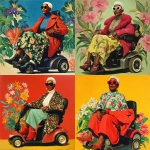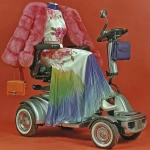Explore the Best AI Image Gallery

Beyond Pixels: How Wearable Tech is Transforming Creative Expression
The realms of art, design, and innovation have always been driven by a desire to push boundaries and explore new frontiers. And in recent years, wearable technology has emerged as a transformative force, redefining how we create, interact with, and experience the world around us.
From interactive garments that respond to movement to haptic feedback devices that translate sound into tactile sensations, wearable tech is blurring the lines between the physical and digital, empowering artists and creators with unprecedented tools for expression.
Applications Across Artistic Disciplines
The impact of wearable technology extends across a wide spectrum of creative disciplines:
Visual Arts
- Interactive Installations: Imagine walking through an art exhibit where your movements trigger light patterns or sound sculptures, creating a dynamic and personalized experience for each viewer. Wearable sensors can capture movement data and translate it into real-time visual effects, transforming static installations into interactive masterpieces.
- Body as Canvas: Wearable technology enables artists to explore the human body as a canvas for expression. LED garments, projection mapping, and embedded sensors allow artists to create mesmerizing light shows on the body, blurring the lines between performer and artwork.
Music & Sound
- Gesture-Controlled Instruments: Wearable devices can capture hand movements and translate them into musical notes, opening up new possibilities for intuitive instrument control. This allows musicians to create soundscapes and compositions that are deeply connected to their physical gestures.
- Personalized Soundscapes: Imagine headphones that adapt to your emotions or environment, generating personalized soundtracks that enhance your mood or focus. Wearable sensors can track physiological data like heart rate and brainwaves, allowing for the creation of immersive soundscapes tailored to individual needs.
Performing Arts
- Immersive Theatre: Wearables can enhance theatrical experiences by providing actors with real-time feedback on audience reactions. Sensors can track facial expressions and body language, allowing performers to adjust their delivery based on the audiences engagement.
- Interactive Storytelling: Imagine a play where your movement through the theater triggers different scenes or dialogue options. Wearable technology can create dynamic and personalized narratives, empowering audiences to actively participate in the storytelling process.
Ethical Considerations
As with any powerful technology, wearable tech raises important ethical considerations:
- Data Privacy: Wearables collect vast amounts of personal data about our movements, emotions, and interactions. Its crucial to ensure that this data is handled responsibly, with transparent consent practices and robust security measures.
- Accessibility: The cost and complexity of wearable technology can create barriers for certain individuals or communities. Ensuring equitable access to these tools is essential to prevent further digital divides.
- Algorithmic Bias: Like all AI-powered systems, wearable tech can perpetuate existing biases if the algorithms are not carefully designed and trained. Its important to address potential biases in data sets and algorithms to ensure fair and inclusive outcomes.
Future Trends
The future of wearable technology in creative fields is brimming with possibilities:
- Brain-Computer Interfaces: Imagine controlling digital art with your thoughts or translating your dreams into tangible creations. Advancements in brain-computer interfaces could unlock entirely new forms of artistic expression.
- Augmented Reality (AR) & Virtual Reality (VR): Wearable AR and VR devices will continue to enhance creative experiences, allowing artists to build immersive worlds, collaborate remotely, and engage audiences in unprecedented ways.
- Sustainable Materials: The focus on sustainability will drive innovation in wearable tech materials. We can expect to see more eco-friendly fabrics, 3D-printed components, and modular designs that promote longevity and reduce waste.
Conclusion
Wearable technology is not just a technological advancement; its a paradigm shift in how we create, experience, and interact with art. By embracing these innovative tools and addressing the ethical considerations, we can unlock new frontiers of creative expression and shape a future where technology empowers human ingenuity.
](https://images.ai-img.art/thumbnails/150/3c26f61d589d80ee22455916dcf4b5e16460963667f2273ac246195006311786.webp)


](https://images.ai-img.art/thumbnails/150/98359176a3cebe401a3fbe1080c7a4c225231f753dcca1bb018122c07110da26.webp)



](https://images.ai-img.art/thumbnails/150/be43946713256e52e6584c5bc61c9fa513962683a2f91d850d6c03367f3f8f35.webp)







](https://images.ai-img.art/thumbnails/150/4c9c68becc73b14922ac55029bd5c4f700881f5b5d17adbf550dab36e3cc81b6.webp)




](https://images.ai-img.art/thumbnails/150/8ee3c6e7dfd063ad94a9e05b0a14723e643fad0b300cddee134a11afdf92e19d.webp)




](https://images.ai-img.art/thumbnails/150/2ff105ce7f100c266fde0e63113798b17ef8c4836f02eda1d2bc3dd9dcc27929.webp)


















](https://images.ai-img.art/thumbnails/150/e06828477cb05f687a8e0c00fc196ee22bf20e84064a8ce6425a8f2670a6a3f2.webp)



](https://images.ai-img.art/thumbnails/150/77574caa025ba55169d6a4ed26b8bcf28a7d3e87a032fa938e7627b2a1f71862.webp)
